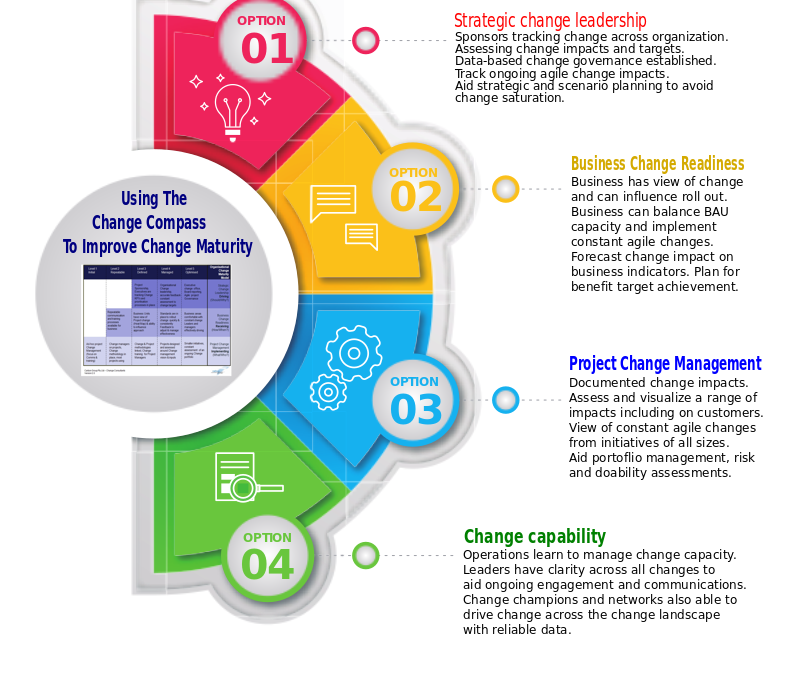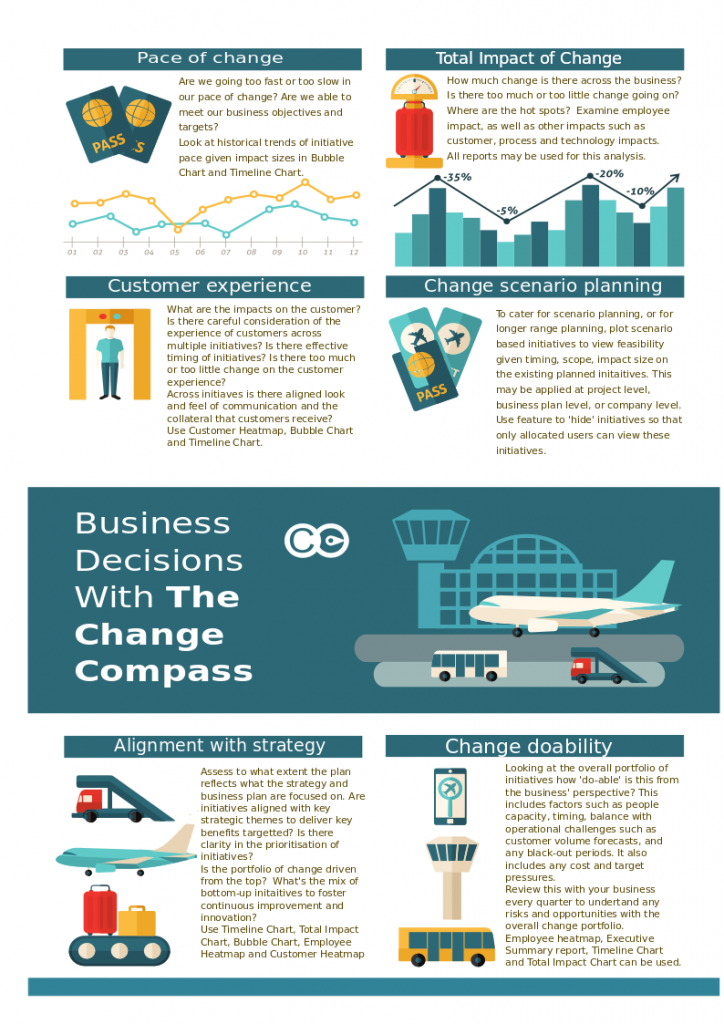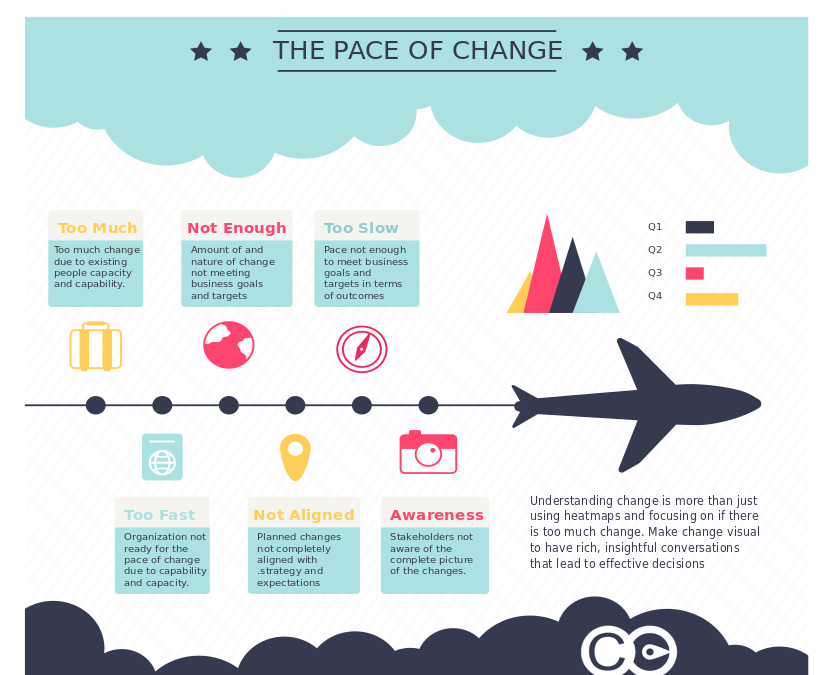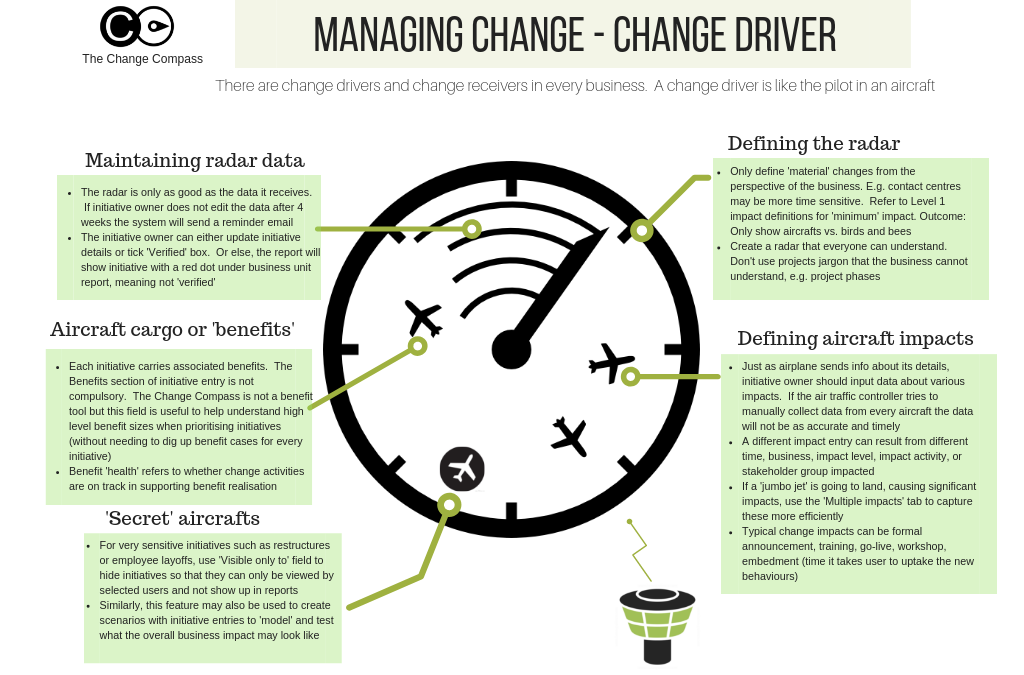
The evolution of change management
Change management has transformed dramatically over decades, evolving from reactive crisis responses to sophisticated, data-driven strategies that predict and shape organizational transformation. Understanding this evolution equips practitioners with insights to navigate modern complexities like digital acceleration, regulatory pressures, and workforce expectations.
This guide traces key milestones in change management development, examines the shift toward strategic data integration, and explores emerging AI-driven capabilities that redefine practitioner roles. Practitioners gain practical frameworks to apply these insights in today’s fast-paced environments.
How Has Change Management Evolved Over Time?
Change management began as structured responses to organizational disruption but matured into proactive disciplines leveraging data and technology. Early approaches focused on resistance management; modern practices emphasize prediction, measurement, and continuous adaptation.
Key evolutionary phases include:
- 1950s-1970s: Foundations in Behavioural Science
Kurt Lewin’s three-stage model (unfreeze-change-refreeze) established foundational principles. Focus remained on human psychology and overcoming resistance through communication. - 1980s-1990s: Structured Frameworks Emerge
John Kotter’s 8-step process and Prosci’s ADKAR model provided systematic approaches. Emphasis shifted to leadership alignment and stakeholder engagement. - 2000s: Enterprise Integration
Change management embedded within project management methodologies like PMI and Agile. Organizations recognized change as a distinct discipline requiring dedicated resources. - 2010s-Present: Data and Analytics Integration
Rise of change portfolio management and adoption metrics tracking. Practitioners began measuring outcomes beyond activities, using dashboards for real-time insights.
This progression reflects growing recognition that successful change requires both human-centered approaches and rigorous measurement.
What Drove the Shift to Strategic Change Management?
Several forces accelerated change management’s maturation:
Digital Transformation Pressures
Rapid technology adoption created simultaneous change waves across organizations. Traditional sequential change approaches proved inadequate for multi-project environments.
Regulatory and Compliance Demands
Increasing scrutiny required demonstrable evidence of change adoption and risk mitigation, pushing practitioners toward measurable outcomes.
Workforce Expectations
Millennial and Gen Z entrants demanded transparency, purpose alignment, and visible progress tracking in change initiatives.
Portfolio Complexity
Organizations managing 10+ concurrent changes needed centralized oversight, leading to change portfolio management practices.
Measurement Maturity
Advancements in HR analytics and adoption metrics enabled practitioners to demonstrate ROI and secure executive support.
These pressures transformed change management from a support function to a strategic capability directly influencing business outcomes.
The Rise of Data-Driven Change Management
Modern change management integrates operational data, adoption metrics, and predictive analytics to guide decision-making.
Strategic Change Data Management
Organizations now maintain centralized repositories tracking change saturation, adoption rates, and portfolio capacity. This enables executives to balance change demands against organizational readiness.
Adoption Metrics Evolution
Beyond activity tracking, practitioners measure micro-behaviours, feature utilization, and sustained proficiency. Real-time dashboards replace periodic reports.
Portfolio Optimization
Data reveals change overlaps, capacity constraints, and high-risk initiatives. Practitioners allocate resources strategically rather than reactively.
Predictive Capacity Planning
Analytics forecast change bandwidth by department and role, preventing saturation and burnout during transformation waves.
This data foundation positions change management as a value-creating function rather than cost centre.
Implementation Frameworks and Best Practices in Modern Change Management
With the evolution of change management into a data-driven discipline, implementation frameworks have also advanced to incorporate strategic alignment, measurement, and agility.
Established Frameworks Adapted for Today’s Environment
Kotter’s 8-Step Process
This enduring framework continues to provide a roadmap for leading change, emphasising urgency creation, coalition building, vision communication, and consolidation of gains. Modern adaptations integrate data points at each step to monitor engagement and effectiveness.
Prosci ADKAR Model
The ADKAR model—Awareness, Desire, Knowledge, Ability, Reinforcement—remains influential for individual change adoption. Data from assessments aligned to each dimension now inform targeted interventions.
Agile Change Management
Agile methodologies bring iterative feedback loops and rapid adaptation, suited for fluid business environments. Incorporating continuous data collection and analytics allows agile teams to pivot change strategies responsively.
Emerging Best Practices
- Integrate Change Management Early in Project Lifecycles: Position change activities alongside project planning for seamless alignment and impact maximisation.
- Embed Data Streams for Real-Time Insights: Utilise adoption metrics, sentiment analysis, and feedback channels to guide decision-making dynamically.
- Foster Cross-Functional Collaboration: Engage stakeholders and change agents across departments to build collective ownership.
- Leverage Technology for Automation: Automate repetitive change management tasks such as communications, survey distribution, and reporting, freeing capacity for strategic priorities.
- Prioritise Employee Experience: Tailor change approaches to diverse workforce needs, using data-driven personas and segmentation.
The Role of AI and Automation in Advancing Change Management
Artificial intelligence and automation are set to redefine how change practitioners operate, transforming strategic decision-making, engagement, and measurement.
AI-Powered Predictive Analytics
By analysing historic change data combined with organisational variables, AI models predict likely resistance points, adoption rates, and saturation thresholds. These insights enable pre-emptive strategies designed to smooth transitions.
Automated Change Interventions
Chatbots and virtual assistants can deliver personalised communications, FAQs, and training modules at scale, maintaining consistent messaging and freeing practitioners’ time for higher-value activities.
Natural Language Processing (NLP) for Sentiment and Feedback Analysis
AI-driven sentiment analysis of employee feedback, surveys, and collaboration platforms identifies emerging issues and morale trends faster than traditional methods.
Intelligent Dashboarding
AI enhances dashboards by correlating disparate data, highlighting risks, and recommending intervention actions. Customisable alerts notify change leaders of critical deviations in real time.
Augmented Decision Support
Machine learning integrates diverse inputs—financial, operational, human factors—to support scenario planning and optimise change portfolios, particularly in complex environments.
Preparing Change Practitioners for the Future
The evolving change landscape requires practitioners to blend traditional soft skills with digital and analytical capabilities. Key skill enhancements include:
- Data literacy and analytics interpretation.
- Familiarity with AI-enabled change tools.
- Agile methodology proficiency.
- Enhanced stakeholder engagement techniques leveraging virtual platforms.
- Continuous learning mindsets to adapt as technologies evolve.
Institutions and organisations should invest in upskilling programs and knowledge hubs supporting these competencies.
Key Takeaways for Change Practitioners
The evolution of change management offers clear guidance for practitioners navigating today’s complex landscape:
Embrace Data as a Strategic Asset
Shift from activity tracking to outcome measurement. Implement real-time adoption dashboards that correlate behaviours with business results, enabling proactive interventions.
Master Portfolio Management Discipline
Treat change as a finite resource. Establish governance processes to assess saturation, prioritise initiatives, and sequence delivery for maximum organisational capacity.
Build Cross-Functional Change Capabilities
Move beyond siloed project support. Embed change expertise within strategy, digital transformation, and HR functions for integrated execution.
Cultivate Continuous Learning Cultures
Position change practitioners as organisational learning facilitators. Use post-initiative reviews and trend analysis to build institutional knowledge.
Emerging Capabilities for Practitioners
AI-Augmented Decision Making
Leverage predictive models to forecast adoption risks and capacity constraints. Use sentiment analysis across communication channels to detect resistance patterns early.
Automation of Change Operations
Streamline repetitive tasks—status reporting, stakeholder mapping, communication scheduling—freeing capacity for strategic advisory roles.
Advanced Measurement Frameworks
Combine traditional metrics with micro-behaviour tracking and network analysis to understand influence patterns and adoption cascades.
Implementation Roadmap for Practitioners
Phase 1: Assessment and Foundation (0-3 Months)
- Conduct change maturity assessment across frameworks and capabilities
- Establish baseline adoption metrics for current portfolio
- Map organisational change capacity by department and role
- Build cross-functional change governance council
Phase 2: Data Integration and Optimisation (3-6 Months)
- Deploy centralised change portfolio tracking system
- Implement real-time dashboards with automated alerts
- Launch pilot AI sentiment analysis on feedback channels
- Standardise post-change review processes
Phase 3: Strategic Evolution (6-12 Months)
- Embed predictive capacity planning in annual cycles
- Scale successful automation across enterprise initiatives
- Develop practitioner upskilling academy
- Establish external benchmarking partnerships
Frequently Asked Questions (FAQ)
How has change management fundamentally evolved?
From reactive resistance management to proactive, data-driven portfolio disciplines that predict capacity and measure sustainable adoption.
What are the most important data capabilities for change practitioners?
Real-time adoption tracking, portfolio saturation analysis, predictive capacity modelling, and cross-initiative impact correlation.
How should organisations structure change governance?
Cross-functional councils with executive sponsorship, portfolio prioritisation processes, and dedicated measurement functions.
What skills will define future change practitioners?
Data analytics proficiency, AI tool fluency, portfolio strategy, systems thinking, and continuous learning facilitation.
Why is change portfolio management mission-critical now?
Concurrent digital, regulatory, and cultural transformations overwhelm traditional approaches. Portfolio discipline prevents saturation and maximises ROI.
How do AI capabilities enhance change effectiveness?
Predictive risk modelling, automated stakeholder engagement, real-time sentiment tracking, and intelligent resource allocation recommendations.
Click the below to download our infographic.










